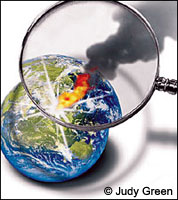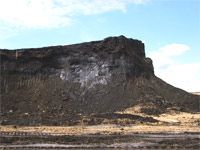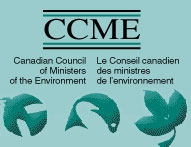
News |
- OlyOpp Alliance Launch to Oppose OlyWest
- Manitoba Boil Water Advisories
- Water-Hungry Las Vegas
- Doer Joins Schwarzenegger for Signing Ceremony
- Environment Commissioner Issues Wake-Up Call
- Earth Hottest in 12,000 Years
- Alberta Tar Sands Loses Aboriginal Support
- Canada's Forests Worth Billions
- WestJet Offsets Climate Impacts
- Doer Concedes Métis Right to Hunt
- Acid Rain Report - Tar Sands Killing Lakes?
- China's Water Crisis
| OlyOpp Alliance Launch to Oppose OlyWest | 13 October 06 |
 Opponents of a proposed hog processing plant in Winnipeg have banded together to form the OlyOpp Alliance, so that combined voices can drive the proposed OlyWest hog slaughtering and processing plant out of Winnipeg. Opponents of a proposed hog processing plant in Winnipeg have banded together to form the OlyOpp Alliance, so that combined voices can drive the proposed OlyWest hog slaughtering and processing plant out of Winnipeg.The launch of OlyOpp took place Friday October 6th in the St. Boniface industrial park. The alliance, is led by the vocal OlyOpp Group of St. Boniface businesses. 10 candidates in Winnipeg's current civic elections have been endorsed by the OlyOpp Alliance and are committed to halting the proposed hog slaughter and processing project. Marianne Cerilli, candidate for Mayor, also opposes OlyWest. Opposition to OlyWest is growing for various reasons including: odour issues, unresolved concerns regarding waste water treatment and possible contamination, increased pressure on traffic and sewage systems; and support, loans, land and subsidies from provincial and city politicians on a non public deal. "Overall... I've been really shocked about the lack of civility and respect for the citizens of Winnipeg in the steps in the last six months," said Manitoba Wildlands Director, Gaile Whelan Enns. "After reviewing the company's inadequate environmental statements it is clear that they are assuming or have been promised their environmental licence." Visit the OlyOpp Alliance website Visit the OlyWest web site View the October 7, 2006 Winnipeg Free Press article (DOC) View the oct 6 OlyOpp Alliance press release (DOC) View past 2006 Manitoba Wildlands news items: September 14 - CEC Hearings for OlyWest Hog Plant July 20 - Confusion Over OlyWest Hearings May 1 - Opposition to Winnipeg Hog Plant Gains Momentum Sources: OlyOpp Alliance, OlyWest, Winnipeg Free Press |
|
| Manitoba Boil Water Advisories | 11 October 06 |
 52 communities and sites in Manitoba are currently under boil water advisories or boil orders issued by the Manitoba Department of Water Stewardship Office of Drinking Water. 52 communities and sites in Manitoba are currently under boil water advisories or boil orders issued by the Manitoba Department of Water Stewardship Office of Drinking Water.According to the Office of Drinking Water, "Boil Water Advisories are issued for a water system or a water source by a Medical Officer of Health (Manitoba Health) due to a confirmed or suspected bacteriological quality problem. Affected residents and businesses are notified in the event an advisory is issued and provided with instructions on precautionary measures." The current list of boil water advisories includes five communities added to the list in 2006. Seven communities have been under boil water advisories since 2000. The list of communities under boil water advisory is not available online, it can only be obtained by making a request to the Office of Drinking Water. View the Manitoba Water Stewardship Office of Drinking Water View the September 1, 2006 list of Manitoba Communities under Boil Water Advisory (PDF) Source: Manitoba Water Stewardship Office of Drinking Water |
|
| Water-Hungry Las Vegas | 11 October 06 |
 Northern Nevadans are preparing to take on water officials' plan to tap a great system of aquifers that form underground lakes across Nevada (some of them hundreds of miles away) to meet the growing Las Vegas water needs. The Colorado River provides 90 percent of Las Vegas's water, but the city lives on an allocation of water awarded decades ago. As a result, the Southern Nevada Water Authority is attempting to access water that lies underground to the north. Northern Nevadans are preparing to take on water officials' plan to tap a great system of aquifers that form underground lakes across Nevada (some of them hundreds of miles away) to meet the growing Las Vegas water needs. The Colorado River provides 90 percent of Las Vegas's water, but the city lives on an allocation of water awarded decades ago. As a result, the Southern Nevada Water Authority is attempting to access water that lies underground to the north.To carry water to households of Las Vegas, engineers propose a $2 billion hydra-headed pipeline stretching 250 miles. The water authority has started buying ranch property in the county to access water underneath. Water authority officials say there is enough water underground statewide to provide for the ranchers, plus about two-thirds of Las Vegas's annual water needs. The battle is the latest in a long series of skirmishes between Western US cities and rural areas over limited water supplies. Typically, cities win. Coastal California, Phoenix and Salt Lake City all rely on distant groundwater supplies. Following a recent hearing, the Nevada state engineer will make a decision as to how much water Southern Nevada and Las Vegas can take. Legally, all water under Nevada is a state resource, and the state engineer must determine best use. View the August 15, 2006 Washington Post article Source: Washington Post |
|
| Doer Joins Schwarzenegger for Signing Ceremony | 6 October 06 |
 California Governor Arnold Schwarzenegger signed landmark global warming bill AB 32 at September 27, 2006 ceremonies. The legislation makes California the first US state to impose limits on all greenhouse gas emissions. It includes mandatory emissions reduction requirements for major industries like utility plants,
oil and gas refineries, and cement kilns. "This is something we owe our children and our grandchildren," said Governor Schwarzenegger. California Governor Arnold Schwarzenegger signed landmark global warming bill AB 32 at September 27, 2006 ceremonies. The legislation makes California the first US state to impose limits on all greenhouse gas emissions. It includes mandatory emissions reduction requirements for major industries like utility plants,
oil and gas refineries, and cement kilns. "This is something we owe our children and our grandchildren," said Governor Schwarzenegger.Manitoba Premier Gary Doer attended the bill signing as a guest of the governor. "Our vision for Manitoba is growing our economy and protecting our environment through clean energy development and energy efficiency," Doer said. "This is a vision we share with Gov. Schwarzenegger. We think it's important we continue to learn from each other's innovations and be inspired by each other's bold leadership." Doer noted Manitoba businesses are also contributing in the battle against global warming. For example, California has become a major market for Winnipeg's New Flyer Industries, which manufactures hybrid buses for various California counties. To date these buses are not in day to day use on Winnipeg streets. View the September 26, 2006 Government of Manitoba press release View the September 27, 2006 Governor of California press release View the September 27, 2006 CBC News article View the text of California's Bill AB 32 View the Manitoba Wildlands' September 6, 2006 news item Governor of California, Government of Manitoba, CBC News |
|
| Environment Commissioner Issues Wake-Up Call | 6 October 06 |
 Canada's environment commissioner Johanne Gelinas used an embarrassing audit of the former government's failure to adequately address climate change to send a wake-up call that urges Canada's current federal government to act swiftly against the pending climate crisis. Canada's environment commissioner Johanne Gelinas used an embarrassing audit of the former government's failure to adequately address climate change to send a wake-up call that urges Canada's current federal government to act swiftly against the pending climate crisis."The government urgently needs a believable, clear and realistic plan to significantly reduce greenhouse gas emissions," Gelinas said. "It must establish and commit to short and long-term national goals." Gelinas also noted that the government's plan should address the long-neglected need to help Canadians cope with the consequences of climate change. The report said Prime Minister Stephen Harper and his government should not continue to use the lack of progress on Canada's Kyoto targets as an excuse to abandon the international pact. The Harper government scrapped an earlier plan developed by the Liberals to meet Canada's international commitments under the Kyoto protocol when it took office last spring. It has promised to deliver a "made-in-Canada solution" when environment Minister Rona Ambrose releases the plan later in October. View the 2006 Report of the Commissioner of the Environment and Sustainable Development View the September 28, 2006 Commissioner of the Environment and Sustainable Development press release View the September 28, 2006 Ottawa Citizen article View the September 28, 2006 CBC News article View the September 29, 2006 Toronto Star article View the October 4, 2006 Gazette article Sources: Commissioner of the Environment and Sustainable
Development, Ottawa Citizen, CBC News |
|
| Earth Hottest in 12,000 Years | 5 October 06 |
 The world's temperature has increased to levels not seen in at least 12,000 years, climate scientists report in the September 26, 2006 issue of the Proceedings of the National Academy of Sciences. The world's temperature has increased to levels not seen in at least 12,000 years, climate scientists report in the September 26, 2006 issue of the Proceedings of the National Academy of Sciences.The article, Global Temperature Change, also concludes that "global warming of more than ~1°C, relative to 2000, will constitute "dangerous" climate change as judged from likely effects on sea level and extermination of species." The warming of recent decades has forced many species to begin to migrate poleward,but one of the study coauthors, James Hansen of NASA's Goddard Institute for Space Studies, says that migration rate is not fast enough to keep up with the current rate of movement of a given temperature zone, which reached 25 miles per decade in the period 1975 to 2005. James Hansen also noted, "If further global warming reaches 2 or 3 degrees Celsius, we will likely see changes that make Earth a different planet than the one we know." The article comes in the wake of several new studies documenting increased warming and the effects on the environment, particularly in the Arctic.
View the September 25, 2006 ABC News article View the September 25, 2006 Proceedings of the National Academy of Sciences article Global Temperature Change View the September 22, 2006 Baltimore Sun article View the September 20, 2006 Reuters article View the September 5, 2006 Independent UK article on Planet Ark Sources: Proceedings of the National Academy of Sciences, Environmental News Service, ABC News |
|
| Alberta Tar Sands Loses Aboriginal Support | 5 October 06 |
 Aboriginal support for Alberta's oil sands boom is crumbling, as concerns mount that escalating water needs will imperil the Athabasca River - and Aboriginal fisheries. Aboriginal support for Alberta's oil sands boom is crumbling, as concerns mount that escalating water needs will imperil the Athabasca River - and Aboriginal fisheries. The Athabasca Chipewyan, who live 200 kilometres downstream from the heart of the oil sand, announced September 25th they were withdrawing from the Cumulative Environmental Management Association (CEMA). CEMA is a body made up of industry, government, aboriginal and other representatives established to come up with strategies for sustainable development of Alberta's bitumen resources. Pat Marcel, an Elder with the Athabasca Chipewyan, said CEMA was being ignored by the provincial government, and his band did not want to participate in a process that had no influence. The withdrawal means both aboriginal bands downstream from the oil sands are now publicly voicing opposition to the quickening pace of development of the massive tar sands projects. Aboriginal support of the oil sands is "critical," acknowledged Greg Stringham, a vice-president at the Canadian Association of Petroleum Producers. Earlier this month, the Mikisew Cree said they would formally oppose Imperial Oil Ltd.'s Kearl project in October 2006 regulatory hearings because of concern over the industry's use of water. The two bands' opposition follows meetings of 200 First Nations representatives from Alberta, British Columbia and the Northwest Territories to discuss worsening water quality and diminishing supplies as a result of industrial development. View the September 26, 2006 Globe and Mail article View the September 23, 2006 Toronto Star article View the September 8, 2006 Globe and Mail article on Workopolis View the September 7, 2006 Reuters article View the December 5, 2005 MWL news item about the Mikisew Cree Sources: Globe and Mail, Toronto Star, Reuters |
|
| Canada's Forests Worth Billions | 5 October 06 |
 The environmental work of Canada's boreal forests in purifying air and water and the tourism dollars they generate are worth at least $93 billion a year, according to Mark Anielski, an Edmonton-based ecological economist. The environmental work of Canada's boreal forests in purifying air and water and the tourism dollars they generate are worth at least $93 billion a year, according to Mark Anielski, an Edmonton-based ecological economist.Presenting his research at Canada's 10th National Forest Congress, Anielski argued that this value should be taken into account when making decisions about logging, mining and other industrial activity that affects forests. Boreal forests regulate climate by capturing and storing an estimated 67 billion tonnes of carbon in Canada alone - a job worth $1.8 billion, based on the price of carbon emissions from the global insurance industry. The water filtration and erosion control function of boreal peatlands is worth $77 billion, and forests generate billions in tourist spending. Anielski said the boreal is "like a giant carbon bank account," worth at least $160 per hectare. But it's not recognized in national income accounts or the country's gross domestic product, says Anielski, who says the solution is to create a 'natural capital accounting system' to recognize the full value of services provided by boreal forests. "If these ecosystem services were counted, they would amount to roughly 9% of Canada's GDP," Anielski said. "Ignoring these values would is leaving out the combined annual contribution to GDP from Canada's health and social services sector and half of the public services sector." View the September 24, 2006 Canadian Press article in the Toronto Star View the September 25, 2006 Environmental News Service article View the September 24, 2006 Canada Forest Congress press release (DOC) Sources: Canada Forest Congress, Canadian Press, Environmental News Service |
|
| WestJet Offsets Climate Impacts | 28 September 06 |
 WestJet is pioneering climate friendly flights for the airline industry in Canada. The Canadian company has partnered with the website Offsetters.ca and will invest part of the normal cost of airfare to offset the climate and green house gas impacts of air travel in order to be a climate neutral company. WestJet is pioneering climate friendly flights for the airline industry in Canada. The Canadian company has partnered with the website Offsetters.ca and will invest part of the normal cost of airfare to offset the climate and green house gas impacts of air travel in order to be a climate neutral company.Tickets that include the greenhouse gas emissions offset will not cost any more than regular airfare, but these flights are booked by linking to WestJet via the Offsetters.ca website. Offsetters collaborates with Climate Care, a world leader in the provision of sustainable offsets and invests in projects that either use technologies that reduce emissions at source or remove greenhouse gases from the atmosphere by investing in reforestation. Offsetters acknowledges controversy surrounding whether reforestation projects actually provide carbon offsets and support development of a new Gold Standard for offsets, which excludes most forestry projects. Visit the Offsetters.ca website Visit the Climate Care website Source: Offsetters.ca |
|
| Doer Concedes Métis Right to Hunt | 28 September 06 |
 In an interview aired September 15, 2006 by Aboriginal Peoples Television Network (APTN), Premier Gary Doer acknowledged that Métis people today have the right to hunt. The Premier stated that the provincial government is prepared to implement the Powley Decision in Manitoba and honour the right of Métis individuals to exercise their hunting rights. In an interview aired September 15, 2006 by Aboriginal Peoples Television Network (APTN), Premier Gary Doer acknowledged that Métis people today have the right to hunt. The Premier stated that the provincial government is prepared to implement the Powley Decision in Manitoba and honour the right of Métis individuals to exercise their hunting rights.On September 19, 2003, the Supreme Court of Canada, in a unanimous judgment, said that the Powley's, as members of the Sault Ste Marie Métis community, can exercise a Métis right to hunt that is protected by Section 35 of Canada's Constitution. The Manitoba Métis Federation (MMF) and the Government of Manitoba, however, still do not agree on how the Powley Decision should be implemented. The Government of Manitoba will not recognize MMF's harvester cards; they see them as hunting licences and argue that the province does not delegate hunting licensing responsibility to First Nations. View the transcript of the September 15, 2006 APTN news report (DOC) Visit the APTN website Visit the Manitoba Métis Federation website View Indian and Northern Affairs Canada information on the Powley Decision Source: APTN |
|
| Acid Rain Report - Tar Sands Killing Lakes? | 27 September 06 |
 Acid rain has long been a concern in industrialized Central Canada, but a new study suggests it could also be damaging the forest environment in Saskatchewan and Manitoba. Concerns are being raised that one source of this acid rain is Alberta's oilsands. Acid rain has long been a concern in industrialized Central Canada, but a new study suggests it could also be damaging the forest environment in Saskatchewan and Manitoba. Concerns are being raised that one source of this acid rain is Alberta's oilsands. Trent University prepared a (2006) study for the Canadian Council of Ministers of the Environment (CCME), Calculating Critical Loads of Acid Deposition for Forest Soils in Manitoba and Saskatchewan - Final Report: Data Sources, Critical Load, Exceedance and Limitations. It indicates that acidifying emissions are currently degrading highly sensitive soils. Acid rain damages forest soils by stripping soil nutrients and increasing release of toxic chemicals as well as directly damaging some sensitive tree species. The Trent study found 2% of soil studied in Saskatchewan's forest region has acid levels above the threshold that could cause harm to the environment. In Manitoba7% of the forest land, has acid levels above the "critical load." The Canadian Council of Ministers of the Environment (CCME) also recently released the 2004-2005 Progress Report on The Canada-Wide Acid Rain Strategy for Post-2000. The Canada-Wide Acid Rain Strategy for Post-2000 was signed by all 26 provincial Energy and Environment Ministers October 19, 1998. The Strategy is a framework to resolve the acid deposition problem in eastern Canada and ensure that new acid deposition problems do not occur elsewhere in Canada. View the September 2006, Trent University/CCME study, Calculating Critical Loads of Acid Deposition for Forest Soils in Manitoba and Saskatchewan - Final Report (PDF) View the September 14, 2006 CBC News article Visit the CCME web page on Acid Rain View the August 2006 2004-2005 Progress Report on The Canada-Wide Acid Rain Strategy for Post-2000 (PDF) View the 1998 Canada-Wide Acid Rain Strategy for Post-2000 (PDF) View the CBC feature on acid rain Source: CBC News, Canadian Council of Ministers of the Environment (CCME) |
|
| China's Water Crisis | 27 September 06 |
 Persistent drought conditions in China highlight the country's alarming water scarcity problems. China boasts approximately one fifth of the world's population but only seven percent of its water supply. The 1.3 billion people of the world's most populous country have at their disposal only a quarter of the water per person available on average around the world. Persistent drought conditions in China highlight the country's alarming water scarcity problems. China boasts approximately one fifth of the world's population but only seven percent of its water supply. The 1.3 billion people of the world's most populous country have at their disposal only a quarter of the water per person available on average around the world. Pollution has left half of the China's river water suitable only for agricultural and industrial use, making fresh drinking water a luxury for China's 800 million peasants. Roughly 400 of China's 600-odd cities are short of water, according to the Water Ministry. In Beijing and 100 other cities, water shortages are deemed "extreme". More than two-fifths of cities, and tens of millions of rural dwellers pump used water directly into rivers. China's Water Ministry predicts that by 2008 - the year Beijing plays host to the Summer Olympic Games - the water crisis would leave Beijing short by as much as 1.1 billion cubic meters of water. Beijing has pledged to spend 1 trillion Yuan ($125 billion) over five years to improve urban water security and build sewage-treatment systems. Another $5 billion has been allocated to improve water supply in rural areas. Experts say China's bid to tackle widespread pollution and water treatment facilities shortages could make it a leader in waste management. China has also announced that its first heating and cooling system to use seawater pumps is under construction in the northeast coastal city of Dalian and will begin operation this winter. View the September 12, 2006 Reuters article View the September 12, 2006 Asia Times article View the September 21, WorldWatch Institute news update Sources: Reuters, Asia Times, WorldWatch Institute |
|


 RSS Feeds:
RSS Feeds: